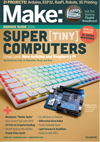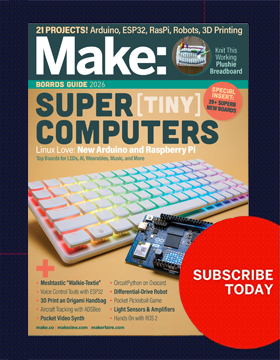The History of the Maker Movement
The maker movement, a global movement celebrating creativity, innovation, and hands-on learning, has transformed how we design, produce, and consume goods. Rooted in the DIY culture of the mid-20th century, the movement gained momentum in the early 2000s with the advent of digital fabrication tools, open-source platforms, and collaborative communities.
An early catalyst was the launch of Make: magazine in 2005 by Dale Dougherty. Our publication became a cornerstone of the movement, providing a platform for DIY enthusiasts to share projects, ideas, and techniques. Dougherty also organized the first maker event, Maker Faire in 2006, an event that showcased the creativity of makers and brought the community together on a global scale.
Before Make: and Maker Faire, creatives and academics were labeled by their specific trade—engineers, crafters, programmers, artists, etc. We started calling the people behind the projects, makers. The term “maker” changed everything. It was a unifying label encompassing all forms of creativity that helped break down barriers and open new doors for collaboration and innovation. The maker movement is more than a hobbyist trend—it’s a cultural shift. It celebrates the power of human ingenuity and reminds us that we can all create, connect, learn, and share while doing what we love.
Another pivotal moment came from MIT’s Center for Bits and Atoms, where Neil Gershenfeld introduced the concept of Fab Labs (fabrication laboratories) in the late 1990s. These labs provided access to digital fabrication tools, enabling individuals to create almost anything. Gershenfeld’s work laid the foundation for the democratization of manufacturing, making advanced tools accessible to the public.
The maker movement is an accelerator for local and global economic growth. It has cultivated millions of makers and hundreds of thousands of prototypes and products, including Arduino, Raspberry Pi, LittleBits, MakerBot, RepRap, Voron, Shaper Tools, Makerblock, Fusion360, TinkerCad, xTool, and so many more, plus thousands of makerspaces and FabLabs and Maker Faires in hundreds of cities and schools around the globe.
The maker movement is more than a trend; it is a cultural shift that celebrates creativity, collaboration, and innovation. From its origins in DIY culture to its current global influence, the movement has empowered individuals to become creators rather than consumers. As technology continues to evolve, the maker movement will continue to play a pivotal role in shaping the future of education, economy, and society.
By embracing the principles of accessibility, sustainability, and learning through doing, the maker movement has proven that anyone, anywhere, can change the world—one project at a time.
2005
- The first issue of Make: Magazine was published in February of 2005 by Dale Dougherty and Tim O’Reilly.
- Make: magazine coins the term “maker”
- Arduino is born
- Make: Volume 4 also features The Maker’s Bill of Rights
- Adafruit Industries founded
2006
Maker Faire launches
- The first ever Maker Faire was held in the Bay Area in San Mateo, California in May 2006. Maker Faire was created by Dale Dougherty, the founder of Make: magazine and the Maker Movement.
- First Make: Books title published, Makers by Bob Parks
- Etsy launches
- TechShop founded
2007
- First Maker Faire Austin [Make Austin Weird]
- NYC Resistor Opened
2008
- Maker Faire Global Licensing program launches. Since its launch in 2008, the Maker Faire Community has been independently produced in over 45 countries in museums, libraries, expo centers, sports arenas, fairgrounds, parks, schools and universities, the White House—anywhere there is room to make together. Making a Maker Faire is not easy; but, the result is nothing short of world changing.
- Thingiverse launched the first open source 3D printing resource repository.
- RepRap Movement and Festivals start
2009
- Make: Television was an American Public Television series that was nominated for an Emmy. The show featured John Park as host and co-writer.
- Best selling Make: Electronics book published written by Charles Platt
- Make: Volume 20, Adam Savage’s space cover
- LittleBits launches at Maker Faire.
- MakerBot founded by Bre Pettis, Adam Mayer, and Zach “Hoeken” Smith to build on the early progress of the RepRap Project
2010
Makerbot makes the cover
- Maker Faire comes to New York and Detroit for the first time.
- First Open Source Hardware Conference at World Maker Faire
- Make: Ultimate Workshop + Tool Guide special issue with Adam Savage.
2011
- In August 2011, Autodesk, a leading design software company, acquired Instructables, the popular DIY project-sharing platform, for over $30 million.
- The overall market for 3D printing and similar services reaches 1.7 million dollars.
- Tinkercad public launch
2012
- Makey Robot logo was born! Designed by Kim Dow and inspired by these young makers and their Makey robot creations.
- Raspberry Pi launches with a debut at World Maker Faire New York.
- Maker Camp launches
- NY Times reports “Made in America is on the rise.”
- Prusa launches
2013
- Make: Volume 36 with the first ever boards guide was published, featuring boards that fueled the smart device revolution.
- 3M people pledge $480 million dollars to Kickstarter projects.
- Stratasys acquired MakerBot for $604 million
- Autodesk Fusion 360 released
2014
- President Obama welcomes the first ever Maker Faire at the White House in Washington D.C.
- Make: Volume 39 with Grant Imahara on the cover
- Year of the Maker
2015
- The first micro:bit launched in 2015, honoring the BBC’s legacy of computing that stretches back to the original BBC Micro computer of the 1980s.
- Glowforge was founded at Maker Faire Bay Area 2015 and launched a crowdfunding campaign that raised nearly $28 million in preorders, making it one of the most successful crowdfunding campaigns at the time.
2016
- 26% of US cities have makerspaces and 13% have hosted a Maker Faire.
- 10th Maker Faire Bay Area is held in San Mateo.
- Rebble: Pebble smartwatch Reborn
- Maker Update launched by Donald Bell
- Lightburn software launched
2017
- Adafruit Industries introduced the Circuit Playground Express, a versatile microcontroller board designed for education and prototyping
- The Raspberry Pi Foundation launched the Raspberry Pi Zero W, a compact and affordable single-board computer with built-in Wi-Fi and Bluetooth capabilities. This made it easier for makers to integrate wireless functionality into their projects.
2018
- Creality launched the Ender 3, an affordable and highly popular 3D printer that became a staple in the maker community. Its ease of use, modifiability, and low cost made it an excellent choice for both beginners and experienced makers
- 375 Maker Faires span 44 countries and welcoming 1.3 million attendees worldwide.
- Instagram Shop launches allowing creators to sell from their platform
2019
- DJI introduced the Osmo Action, a compact action camera featuring 4K resolution, dual color screens, and RockSteady image stabilization technology, catering to adventure enthusiasts and content creators
2020
COVID-19 Pandemic Hits
- Production of Personal Protective Equipment (PPE): As the pandemic led to critical shortages of medical supplies, makers worldwide mobilized to produce PPE. Utilizing 3D printers and other tools, they created face shields, masks, and ventilator components to support healthcare workers
- Open-Source Medical Designs: The maker community collaborated online to share and refine open-source designs for medical equipment, ensuring rapid dissemination and local production capabilities
- The COVID-19 pandemic mobilized makers to fight the disease, and Make: Volume 73 captured their story
- Virtual Maker Faire Global Event – 36 hours of live programming in 17 time zones, May of 2020
- Virtual Maker Camp launches
2021
- Maker Campus offers virtual workshops for makers by makers
- Creator economy and community booms on Youtube
2022
- The Amazing Maker Awards, also known as “The Makeys,” was a juried competition hosted by Make: that recognizes and celebrates the creative, technical, and social contributions of makers and their projects, showcasing the most amazing projects in an annual online exhibition.
- Make: Volume 80, Win the War on Repair
- 555 chip turns 50
2023
Maker Faire Bay Area Returns
- After a three-year pause due to the COVID-19 pandemic, Maker Faire Bay Area is back in a new location at Mare Island’s Naval Shipyard
- The Maker Movement continued its global reach with 144 Maker Faires held across 26 countries and five continents in 2023. This widespread participation highlighted the movement’s international appeal and the universal desire for hands-on creativity
2024
Resilience Amid Challenges: Despite economic headwinds, 40% of small businesses reported revenue increases in 2024. Looking ahead, 50% of small business owners expressed optimism for revenue growth entering 2025, indicating a positive outlook for the sector
2025
Make: Magazine Volume 92 – 20th Anniversary Issue!
Wow, it’s been 20 years since Make: magazine hit newsstands and mailboxes. We wouldn’t be here without you! In Make: Volume 92 we got the original magazine team back together to give a behind-the-scenes look at creating the very first issue, and asked Fab Labs guru Neil Gershenfeld and visionary tech publisher Tim O’Reilly to look back at 20 years of the Maker Movement.
We'll assume you're ok with this, but you can opt-out if you wish.
Our websites use cookies to improve your browsing experience. Some of these are essential for the basic functionalities of our websites. In addition, we use third-party cookies to help us analyze and understand usage. These will be stored in your browser only with your consent and you have the option to opt-out. Your choice here will be recorded for all Make.co Websites.




